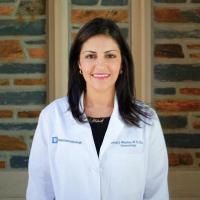Structured Illumination Microscopy and a Quantitative Image Analysis for the Detection of Positive Margins in a Pre-Clinical Genetically Engineered Mouse Model of Sarcoma.
Date
2016
Journal Title
Journal ISSN
Volume Title
Repository Usage Stats
views
downloads
Citation Stats
Abstract
Intraoperative assessment of surgical margins is critical to ensuring residual tumor does not remain in a patient. Previously, we developed a fluorescence structured illumination microscope (SIM) system with a single-shot field of view (FOV) of 2.1 × 1.6 mm (3.4 mm2) and sub-cellular resolution (4.4 μm). The goal of this study was to test the utility of this technology for the detection of residual disease in a genetically engineered mouse model of sarcoma. Primary soft tissue sarcomas were generated in the hindlimb and after the tumor was surgically removed, the relevant margin was stained with acridine orange (AO), a vital stain that brightly stains cell nuclei and fibrous tissues. The tissues were imaged with the SIM system with the primary goal of visualizing fluorescent features from tumor nuclei. Given the heterogeneity of the background tissue (presence of adipose tissue and muscle), an algorithm known as maximally stable extremal regions (MSER) was optimized and applied to the images to specifically segment nuclear features. A logistic regression model was used to classify a tissue site as positive or negative by calculating area fraction and shape of the segmented features that were present and the resulting receiver operator curve (ROC) was generated by varying the probability threshold. Based on the ROC curves, the model was able to classify tumor and normal tissue with 77% sensitivity and 81% specificity (Youden's index). For an unbiased measure of the model performance, it was applied to a separate validation dataset that resulted in 73% sensitivity and 80% specificity. When this approach was applied to representative whole margins, for a tumor probability threshold of 50%, only 1.2% of all regions from the negative margin exceeded this threshold, while over 14.8% of all regions from the positive margin exceeded this threshold.
Type
Department
Description
Provenance
Citation
Permalink
Published Version (Please cite this version)
Collections
Scholars@Duke

Melodi Javid Whitley
Melodi Javid Whitley, MD, PhD
Assistant Professor of Dermatology
Assistant Program Director for Trainee Research
Director of Transplant Dermatology
I am a physician scientist focused on the dermatologic care of solid organ transplant recipients. Clinically, I manage the the complex dermatologic side effects of immunosuppression with a focus on high-risk skin cancer. My research focuses on understanding the drivers of cutaneous malignancy in this population using translational approaches.

Diana Marcella Cardona
I am active in translational research involving gastrointestinal/hepatobiliary pathology [specifically transplant related pathology (GVHD and rejection) and carcinogenesis of the pancreas] and bone and soft tissue malignancies [imaging techniques for intraoperative margin assessment].

Nimmi Ramanujam
Ramanujam obtained her Ph.D. degree at the University of Texas at Austin. She progressed through the ranks as an academic researcher; the first five years as a research scientist and postdoctoral fellow at the University of Pennsylvania, the next five as an assistant professor at the University of Wisconsin, Madison, and the following five as an associate professor in the Department of Biomedical Engineering at Duke University. In 2011 she was promoted to full professor. Ramanujam is internationally recognized for her contributions in innovation, education and entrepreneurship and received numerous awards most notably, the IEEE Biomedical Engineering Award Technical Field Award and the Social Impact Abie award . She is a Fulbright scholar, a member of the National Academy of Inventors, and a fellow of international professional societies in her field. She has also been invited for speaking engagements at the United Nations, as a TEDx speaker, and been invited to give plenary talks on her work all over the world.
Ramanujam addresses pressing challenges in women’s cancers, specifically, cervical and breast cancer. Ramanujam creates technologies that transform complex diagnostic instruments and therapies into accessible, affordable, and appropriate solutions. Several of these products are now being used in several countries in the U.S., Latin America, and Africa. She has developed a network of partners including academic institutions and hospitals, non-governmental organizations, ministries of health, and commercial partners to implement these technologies in diverse healthcare settings globally.
She has used her expertise in imaging and human-centered design to develop the Pocket colposcope which is on the WHO list of devices for cervical cancer imaging. A sister device, the Callascope is a self-use speculum-free imaging device, which allows women to screen themselves privately without the need for an intrusive pelvic exam. She has developed a translational microscope called the CapCell Scope to identify biomarkers of metabolism that reflect tumor behavior, including growth, proliferation, and treatment resistance, aimed at informing drug selection for breast cancer treatment. She has developed an ultra-low-cost injectable liquid ablation therapy that disrupts tumors locally as well as elicits an anti-tumor immune response to address an important gap – the lack of access to surgery to the world’s most vulnerable populations.
Ramanujam has also created several global initiatives that strive to achieve enduring impact in health and education. Her innovations have a common wellspring - they are all connected and come from a place of wanting to create and make something that doesn’t exist.
The most prominent is a consortium called Women Inspired Strategies for Health (WISH) to improve cervical cancer prevention in low-resource settings globally. She is working with partners worldwide to ensure that technologies and strategies for addressing cervical cancer are adopted by cancer control programs in geographically and economically diverse healthcare settings. These partnerships have resulted in see-and-treat cancer control strategies in the least resourced settings that are in clinical deserts. WISH has been recognized by the MacArthur Foundation as one of the top 100 most transformative and impactful solutions, a testament to its significance in redesigning the health system.
Ramanujam has launched an arts and storytelling initiative, The Invisible Organ to raise awareness of sexual and reproductive health inequities. An educational documentary with a similar name was created and has been screened at conferences and by multiple artists and students across the U.S. This film was officially selected for the Women at the Center Film Festival at the International Papillomavirus Conference in 2020. She also co-led the curation of an art exhibit to bring together a collection of visual arts, medical photography, sculptures, and installations, both a physical exhibit and a digital moving gallery to express the stigma and shame associated with female anatomy.
She has also created a global education program that intersects design thinking, STEM concepts, and the U.N. Sustainable Development Goals to promote social justice awareness: Ignite. The participatory learning curricula have been implemented in more than four countries with broad-ranging impact. For example, students living around the contaminated Lake Atitlan, in Guatemala learned how to design engineering solutions for clean water. Similarly,for personal use during frequent power outages.
Unless otherwise indicated, scholarly articles published by Duke faculty members are made available here with a CC-BY-NC (Creative Commons Attribution Non-Commercial) license, as enabled by the Duke Open Access Policy. If you wish to use the materials in ways not already permitted under CC-BY-NC, please consult the copyright owner. Other materials are made available here through the author’s grant of a non-exclusive license to make their work openly accessible.
